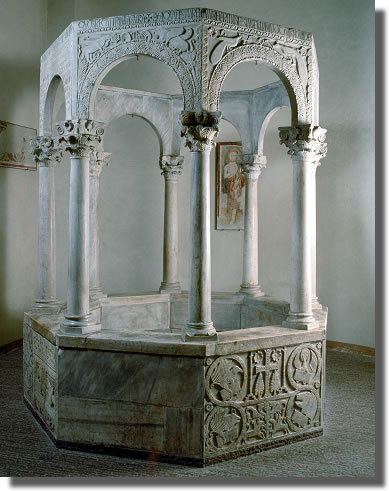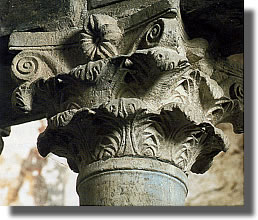CIVIDALE DEL FRIULI
The Tegurium of Callixtus
 |
The decorative covering called a Tegurium, was added under Patriarch Callixtus to the octagonal Baptismal font of the Basilica of Santa Maria and represents the most wellknown and important sculptural example of the so-called “Liutprandean Renaissance”, which can be referred to the artistic climate of the reign of King Liutprand (712-744).
|
The Tegurium consisted of a series of eight small marble arches on columns bearing refined, elegant capital sculpted in an imitation of the corinthian style, with acanthus leaves, volutes and a central rosette, which strove to echo early christian examples.
The arches rose all around the font, over the points in which two sides of the octagonal parapet joined up, and where baptisms were performed with a triple immersion into the water font.

The small arches’ decorations are framed by bands of intricate motifs and vegetal volutes, and include peacocks, lions, lambs, fishes, griffons, and deer, sculpted with a fresh, realistic style. the figures are shown in couples, facing each other, and are placed on the sides of the archivaults and surrounded by other decorative floral elements.
They are meant as Christian symbols of redemption, as the animals drink from the source of salvation, the main theme in a baptismal context.
On the upper ledge of the arches runs a dedicatory inscription in capital characters which explicitly calls to mind the patronage of Patriarch Callixtus.
A further possibility of refining the chronological context of this artefact would be the mention of Liutprand and his son Hildebrand, who reigned until 744, and inscribed on an arch found in the 16th century in the Duomo’s paving, which has been identified as an element originally belonging to the Tegurium. This would allow a dating of the work between 737 and 744.







